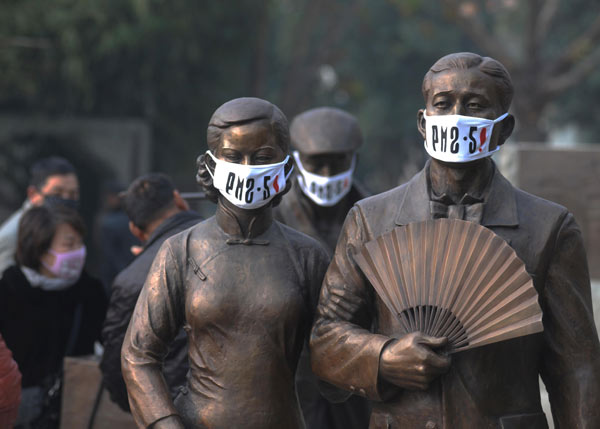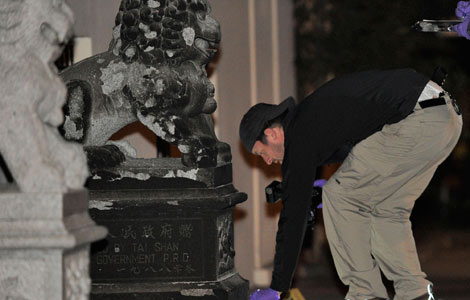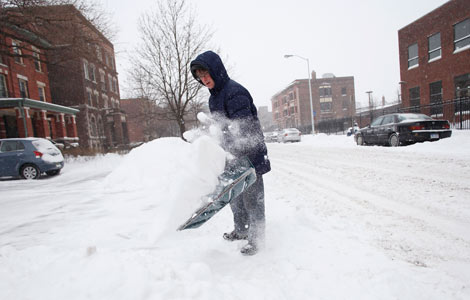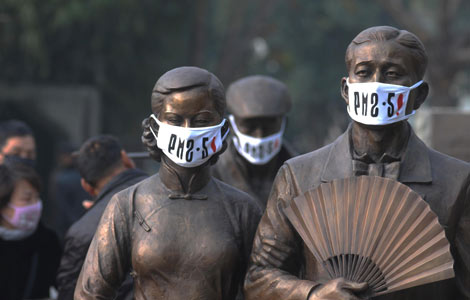Beijing sees little improvement in air quality in 2013
Updated: 2014-01-03 01:53
By Zheng Xin (China Daily)
|
||||||||
|
 |
|
Street statues in Wuhan, Hubei province, on Dec 25 reflect ongoing public concern with PM2.5 pollution. Liu Dajia / For China Daily |
Despite pledges in the last year to fight pollution, Beijing saw barely any improvement in air quality in 2013.
The intensity of major air pollutants remained much the same in 2013 as they were in the previous year, figures released by the Beijing Environmental Protection Bureau on Thursday indicate.
PM2.5, airborne particulate matter smaller than 2.5 micrometers in diameter, was 2.5 times the national standard, it said.
Authorities began to monitor and publish PM2.5 levels in 2013.
"It's a long process to fight the capital's pollution," Fang Li, spokesman for the bureau, said at a news conference on Thursday.
The PM2.5 reading in 2013 was on average 89.5 micrograms per cubic meter. By comparison, the national standard stands at 35 micrograms per cubic meter.
PM2.5 was found to be the major pollutant — accounting for 77.8 percent — on most smoggy days.
Southern Beijing saw much higher PM2.5 readings in 2013 compared with the north.
As for other major air pollutants, the figures showed a slight reduction in the average intensity of sulfur dioxide and PM10 compared with 2012, but nitrogen dioxide increased by 7 percent year-on-year.
The most heavily polluted days were in January 2013, seriously affecting the year's average reading, said Yu Jianhua, a Beijing Environmental Protection Bureau official.
Zhang Dawei, head of the Beijing Environmental Monitoring Center, said that compared with 1998, the intensity of sulfur dioxide declined by 78 percent, nitrogen dioxide by 24 percent and PM10 by 43 percent.
But considering the rising number of automobiles and the increasing energy consumption in all walks of life, Beijing's goal to reduce PM2.5 concentration to 60 micrograms per cubic meter by the end of 2017 — down 25 percent from 2012 — will "remain very challenging", he said.
"The stricter standards require the capital to come up with more stringent measures," he said.
A report released by the Chinese Academy of Sciences on Monday said secondary inorganic aerosols — fine, solid particles comprising sulfate and nitrate that result from a photochemical reaction — are responsible for 26 percent of Beijing's PM2.5, whereas vehicle emissions account for about 4 percent.
However, the bureau contradicted that report on Thursday, saying that automobile emissions are still the major source of PM2.5 in Beijing.
Figures from the bureau reveal that automobile emissions account for 22.2 percent of PM2.5 concentration, after pollution from neighboring provinces (24.5 percent). It is followed by coal consumption (16.7 percent), industrial pollution (16.3 percent) and dust (15.8 percent).

 The Lego version of Downton Abbey
The Lego version of Downton Abbey
 Police probe fire attack on Chinese consulate
Police probe fire attack on Chinese consulate
 Powerful storm brings Arctic cold, snow to US Northeast
Powerful storm brings Arctic cold, snow to US Northeast
 Beijing sees little improvement in air quality in 2013
Beijing sees little improvement in air quality in 2013
 125th Rose Parade celebrated in US
125th Rose Parade celebrated in US
 Cold doesn't dissuade 'Polar Bear Swimmers'
Cold doesn't dissuade 'Polar Bear Swimmers'
 First photos of Liaoning battle group made public
First photos of Liaoning battle group made public
 US First Family out for shave ice in Hawaii
US First Family out for shave ice in Hawaii
Most Viewed
Editor's Picks

|

|

|

|

|

|
Today's Top News
FBI Investigates fire at Chinese Consulate
Snowstorm pushes into US Northeast
Smog may affect mental health
Chinese helicopter saves 52
Bill de Blasio: New York “won’t wait” to tackle inequality
Kim seeks ROK ties, warns US of nuclear 'disaster'
NGO sends SOS on funding
Strong China-US trade and investment links
US Weekly

|

|






